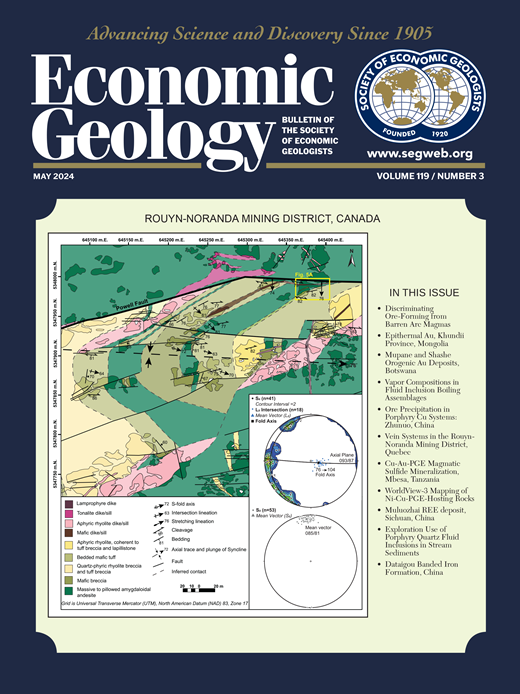碎屑岩为主(cd型)锌矿床中层状主岩自维持反应的置换
IF 4.9
1区 地球科学
Q1 GEOCHEMISTRY & GEOPHYSICS
引用次数: 1
摘要
层状到层控的硅-塑性-碳酸盐混合宿主岩置换是许多沉积型贱金属矿床的一个显著特征。碎屑型(cd型)铅锌矿床的矿化岩一般较薄(101 m),横向展布(103 m),呈层-层状,呈细粒粉砂岩和泥岩相,是我们价值最高的贱金属资源。在最近发现的Teena cd型铅锌矿床(澳大利亚卡奔塔利亚省元古宙)中,主岩经历了埋藏成岩作用,并被热液流体蚀变和矿化,热液流体通过地层内层段向流体输入管道(生长断层)横向移动2 km。在大部分矿床中,碳酸盐溶解是一个重要的反应渗透率控制因素,尽管大量的矿化也发生在无碳酸盐的硅塑性层中。在这项研究中,透射电子显微镜(TEM)数据已经在岩心样品上生成,该岩心样品保留了细粒硅塑性成分端元(无碳酸盐)的矿化和非矿化区域之间的尖锐反应前沿。岩石学和矿物学资料表明,氧化热液流体通过长石溶蚀形成的反应渗透性穿过原岩。反应性流体流动的性质是由发生在流体-矿物界面的反应决定的。热液共生初期黄铁矿的形成增加了原岩中矿物活性表面积。然后,通过黄铁矿氧化、瞬态硫酸铁生成和闪锌矿沉淀等自维持反应,在原位产生酸性,这些反应提供了正反馈,促进了孔隙度的形成,进一步促进了流体的渗透和矿化。然而,在没有碳酸盐的情况下,钾长石溶解(~4.5)缓冲了矿液pH,从而确保在更酸性的条件下,闪锌矿的沉淀不会受到抑制。卡奔塔利亚省所有cd型矿床均由碳酸盐、钾长石、黄铁矿和有机质组成的原岩赋存;这些相为成矿过程中自持反应的发展设定了边界条件。重要的是,这些自我维持的反应代表了一个金矿形成的适居带,适用于其他通过取代混合硅-塑性-碳酸盐寄主岩石(例如层状铜)而形成的沉积物矿床。本文章由计算机程序翻译,如有差异,请以英文原文为准。
Stratiform Host-Rock Replacement via Self-Sustaining Reactions in a Clastic-Dominated (CD-Type) Zn Deposit
Stratiform to stratabound replacement of a mixed siliciclastic-carbonate host rock is a defining characteristic of many sediment-hosted base metal deposits. Mineralized rocks in clastic-dominated (CD-type) Zn-Pb ore deposits, which represent our highest value base metal resources, are generally thin (101 m), laterally extensive (103 m), and stratiform to stratabound in fine-grained siltstone and mudstone facies. At the recently discovered Teena CD-type Zn-Pb deposit (Proterozoic Carpentaria Province, Australia), the host rock was undergoing burial diagenesis when altered and mineralized by hydrothermal fluids that moved up to 2 km lateral to the fluid input conduit (growth fault) through intraformational intervals. In much of the deposit, carbonate dissolution was an important reaction permeability control, although significant amounts of mineralization also occur in carbonate-free siliciclastic beds. In this study, transmission electron microscopy (TEM) data has been generated on a drill core sample that preserves a sharp reaction front between mineralized and unmineralized domains of the fine-grained siliciclastic compositional end member (carbonate free). Petrographic and mineralogical data provide evidence that oxidized hydrothermal fluids moved through the protolith via reaction permeability that developed from feldspar dissolution. The nature of reactive fluid flow was determined by reactions that took place at the fluid-mineral interface. Pyrite formation during the earliest stage of the hydrothermal paragenesis increased the mineral reactive surface area in the protolith. Acidity was then generated in situ via self-sustaining reactions involving pyrite oxidation, transient Fe sulfate formation, and sphalerite precipitation, which provided positive feedbacks to enhance porosity creation and further fluid infiltration and mineralization. In the absence of carbonate, however, ore fluid pH was buffered by K-feldspar dissolution (~4.5), thereby ensuring sphalerite precipitation was not inhibited under more acidic conditions. All CD-type deposits in the Carpentaria Province are hosted by a protolith comprising carbonate, K-feldspar, pyrite, and organic matter; these phases set the boundary conditions for the development of self-sustaining reactions during ore formation. Importantly, these self-sustaining reactions represent a Goldilocks zone for ore formation that is applicable to other sediment-hosted deposits that formed via replacement of mixed siliciclastic-carbonate host rocks (e.g., stratiform Cu).
求助全文
通过发布文献求助,成功后即可免费获取论文全文。
去求助
来源期刊

Economic Geology
地学-地球化学与地球物理
CiteScore
10.00
自引率
6.90%
发文量
120
审稿时长
6 months
期刊介绍:
The journal, now published semi-quarterly, was first published in 1905 by the Economic Geology Publishing Company (PUBCO), a not-for-profit company established for the purpose of publishing a periodical devoted to economic geology. On the founding of SEG in 1920, a cooperative arrangement between PUBCO and SEG made the journal the official organ of the Society, and PUBCO agreed to carry the Society''s name on the front cover under the heading "Bulletin of the Society of Economic Geologists". PUBCO and SEG continued to operate as cooperating but separate entities until 2001, when the Board of Directors of PUBCO and the Council of SEG, by unanimous consent, approved a formal agreement of merger. The former activities of the PUBCO Board of Directors are now carried out by a Publications Board, a new self-governing unit within SEG.
 求助内容:
求助内容: 应助结果提醒方式:
应助结果提醒方式:


